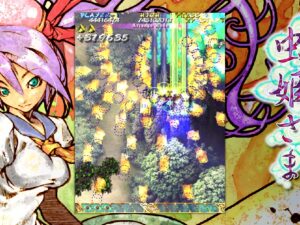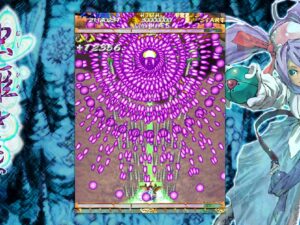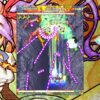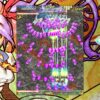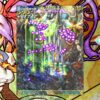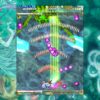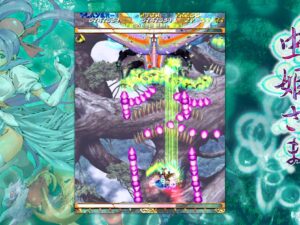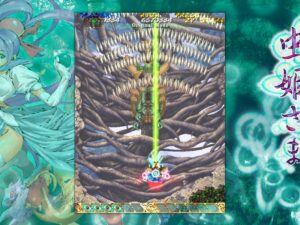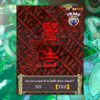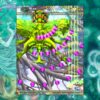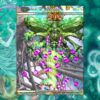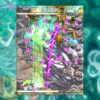Mushihimesama games are some of the most well-known games produced by Cave, next only to the legendary DoDonPachi series. It’s not hard to see why as they’re very well designed vertical shooters with an unusual art style (which has a lot to do with their setting as it’s inspired by Nausicaa of the Valley of the Wind as opposed to the usual space, military and space military that is common in the genre), memorable music and a great amount of challenge.
The first game in the series is fairly old now as it came out in 2004 but for many players in the West this year’s Steam release is the first chance to play it: the arcade machine and PlayStation 2 version were not released outside of Japan, the Xbox 360 port was region-locked on top of that and until now the only port which made it to Europe and America was the iOS release.
Mushihimesama tells a story of Reco, a girl living in a world where humans are nearly extinct and everything is ruled by giant insects. Unfortunately for the protagonist, she is chosen to be sacrificed to those creatures so that they leave humans alone. To survive, Reco flies into the mysterious Shinju forest on the back of a giant, friendly beetle and searches for the only person who can save her – a god of the insects.
The plot is rather minimal, told mostly by supplementary material, some voiceovers at the start of each level (which sound like very good voice acting but it’s kind of hard to tell given that it’s not translated from Japanese) and the ending cutscenes – not a bad thing in a shoot-em-up game given that it doesn’t get in the way of gameplay, explains the nature theme that is prevalent in the game and even gives excuses for some gameplay mechanics (e.g. the hitbox is smaller than a sprite because Reco is vulnerable to the energy attacks of the game’s insect enemies but the beetle isn’t because he is one of them).
The story is, of course, one of the least important things about the game. It is a shmup after all and as such is defined by its mechanics. Mushihimesama’s basic gameplay is a fairly standard Cave fare: there are three shot types, the opposition comes in form of hordes of easy to kill popcorn enemies, occasional bigger ones who go out in satisfying explosions (while also cancelling nearby bullets) and huge bosses.
The screen is often covered by the complex patterns of enemy attacks through which the player must navigate by utilizing the character’s small hitbox and alternating between normal (tapping primary fire button or pressing an alternate one) and focused (pressing primary fire button; slows the player down and makes the attack stronger but more narrow) shots and if things go really badly, it’s always possible to drop a screen-clearing bomb.
Unlike in most Cave shooters, player collects not only powerups but also options (small, invulnerable ‘helpers’ – this time in the form of smaller beetles) which either fly in formation or follow the player. It’s also possible to change shot type during the game by waiting for a few seconds (indicated by a progress bar around powerup icon) before collecting a powerup.
Mushihimesama and its sequel are known for their extreme difficulty, best exemplified by the ‘HARDEST VIDEOGAME BOSS EVER’ YouTube videos showing the second game’s true final boss. While it is true that these games can be very hard, the difficulty is actually very adjustable, allowing players of all skill levels to have fun with the game.
There are three main difficulties in Mushihimesama: Original, Maniac and Ultra. Each of them ups the density and complexity of enemy attack patterns but there is also a difference in scoring system: players in Original are awarded points for destroying the enemies and collecting items, with significant end-level bonuses for the same things done during the current level on the current life and for playing up to that point without dying – thus, high scores are given more or less for doing well.
Maniac and Ultra add a combo system to the mix which works similar to how it worked with DoDonPachi bosses (not during the stages!): a counter goes up when your attacks are connecting with the enemies and goes down when it’s not. This of course rewards memorization and route planning so that the player keeps hitting the enemies for the duration of whole levels.
Each of the three difficulty levels has also its ‘novice’ equivalent for those who are not yet at the skill level required for clearing the normal game without continuing – they’re still challenging but much more manageable and because they keep the original enemy placement and have similar (but easier) attack patterns, they’re very good for learning the game.
Mushihimesama also features an additional gameplay mode known as Arrange Mode. It’s an altered version of the Maniac mode in which the player starts with full power and an autobombing feature: if you’re hit while carrying at least one bomb, the whole bomb stock is depleted (unfortunately, the resulting explosion is only as powerful as a single bomb) but you don’t lose a life.
It also appears to have a different scoring system which I haven’t fully grasped yet but which according to the Internet centers around additional hit counters for each option which can be added to the normal hit counter by changing between normal and focused shots in strategic moments. Arrange mode features a different soundtrack which sounds pretty awesome, especially the stage 2 music.
Additional gameplay mode (with a further choice between Original, Maniac and Ultra difficulties) is available as a DLC and called Mushihimesama v. 1.5. This DLC is based on a very rare version of the game’s arcade machines which, in addition to normal gameplay, allow for starting the game with maximum firepower and autobombing (albeit with only one bomb at the beginning of each life) like in Arrange Mode.
Playing with maximum firepower also changes the scoring system almost completely changed: the game now has a ‘rank’ system (dynamic difficulty) which increases when collecting gems. Rank also works as a score multiplier, thus creating a risk vs reward system: players who play for score will try to get as many gems as possible while those who just try to survive until the end will avoid them. Similar system has been a part of the game’s sequel, Mushihimesama Futari.
The PC version of Mushihimesama features all the standard features of an arcade shooter port: there are online leaderboards, achievements (which can do a good job of introducing people unfamiliar with shmups to things like 1cc), ‘tate’ mode (rotating the screen so that the game runs in correct aspect ratio; this of course requires you to also physically rotate your display device), slowdown emulation (the game intentionally slows down during intense moments the way it would on the original arcade hardware so that it doesn’t become harder when played on modern computers), replays, training mode (playing single stages only) etc.
It’s all done pretty well, although I do have a minor usability gripe: while it is possible to restart the current stage if you screw up, the game treats it like cheating and locks you out from leaderboards and achievements for the duration of this run. It’s all fine and good but why no option to just start the game from the beginning? If I die in early stages, I usually want to try again without losing a chance to get a high score and the only way to do that is to return to the title screen, choose desired difficulty, choose a shot type, listen to intro voiceovers and only then start playing. Also, for some reasons the game remembers all changes I make to the settings except of full screen, which needs to be enabled each time I run the game.
Mushihimesama is an incredibly fun shooter with tight controls, a lot of challenge, great audiovisual style and astonishing bullet patterns. If there’s one thing to complain about, it’s the relatively high price tag. The game costs $20 and DLC is $5 which doesn’t seem much until you remember that the game has been first released eleven years ago and its mobile version is available for free.
The port itself is well done with slowdown where it should be and no noticeable bugs but it’s also worth noting that it’s almost completely the same as the Xbox 360 version, save for the keyboard support. It’s not a lazy port by any measure (sure, it’s not possible to play in arbitrary resolutions but that’s basically a given in shmups ported from arcade), the game has a lot of content and the version on which it was based was only released in Japan so it all really boils down to how much are you willing to pay for a fairly old game – because the game is more than worth playing.
Mushihimesama was reviewed on PC using a digital copy provided by Degica. You can find additional information about Niche Gamer’s review/ethics policy here.
The Verdict: 9
The good:
- Incredibly well designed bullet hell shooter which will challenge both veterans and newcomers
- Different gameplay modes allowing for a lot of replayability
- Very good audiovisual style with pleasant graphics and catchy music
The bad:
- Price is rather high for a game from 2004
- Minor usability issues


